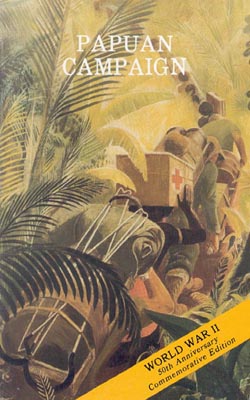PAPUAN CAMPAIGN
The Buna-Sanananda Operation
16 November 1942 - 23 January 1943

CENTER OF MILITARY HISTORY
UNITED STATES ARMY
WASHINGTON, D.C., 1990
First printed by the Historical Division, War Department, for the American
Forces in Action series, 1945
CMH Pub 100-1
For sale by the Superintendent of Documents, US. Government Printing Office,
Washington, D.C. 20402
Foreword to CMH Edition
Papuan Campaign: The Buna-Sanananda Operation (16 November 1942-23
January 1943) is one of a series of fourteen studies of World War II
operations originally published by the War Department's Historical Division
and now returned to print as part of the Army's commemoration of the fiftieth
anniversary of that momentous clash of arms. These volumes, prepared by
professional historians shortly after the events described, provide a concise
summary of some of the major campaigns and battles fought by American soldiers.
The skillful combination of combat interviews with primary sources, many
of which are now lost, gives these unassuming narratives a special importance
to military historians. The careful analysis of key operations provides
numerous lessons for today's military students.
I am pleased that this entire group of studies will once again be available
I urge all military students and teachers to use them to enhance our collective
awareness of the skill, leadership, daring, and professionalism exhibited by
our military forebears.
Washington, D.C.
15 September 1989
HAROLD W. NELSON
Colonel, FA
Chief of Military History
Foreword
In the thick of battle, the soldier is busy doing his lob. He has the
knowledge and confidence that his job is part of a unified plan to defeat
the enemy, but he does not have time to survey a campaign from a fox hole.
If he should be wounded and removed behind the lines, he may have even
less opportunity to learn what place he and his unit had in the larger
fight.
American forces in action is a series prepared by the War Department
especially for the information of wounded men. It will show these soldiers,
who have served their country
so well, the part they and their comrades played in achievements which
do honor to the record of the United States Army.
s/G. C. Marshall
G. C. MARSHALL,
Chief of Staff
v
WAR DEPARTMENT
HISTORICAL DIVISION
WASHINGTON 25, D. C.
Papuan Campaign: the Buna-Sanananda Operation is the second of
a series called AMERICAN FORCES IN ACTION. The series was prepared at the
suggestion of General of the Army George C. Marshall, Chief of Staff. His
foreword, as used in the original edition, appears on the previous page.
The series was originally designed for military personnel only and primarily
for wounded soldiers in hospitals to tell them the military story of the
campaigns and battles in which they served. With the cessation of hostilities,
Papuan Campaign is released as a public document.
This study was based on the best military records available. Although
in its published form it contains no documentation, the original manuscript,
fully documented, is on file in the War Department. Aerial photographs
are by the Allied Air Forces, S. W. P. A.; all others are by the U. S.
Army Signal Corps.
Readers are urged to send directly to the Historical Division, War Department,
Washington 25, D. C., comments, criticisms, and additional information
which may be of value in the preparation of a complete and definitive history
of the Buna-Sanananda operation.
vi
Table of Contents
vii
viii
Maps
Sketches
ix
Photographs
x
page created 10 July 2001
Return
to CMH Online
